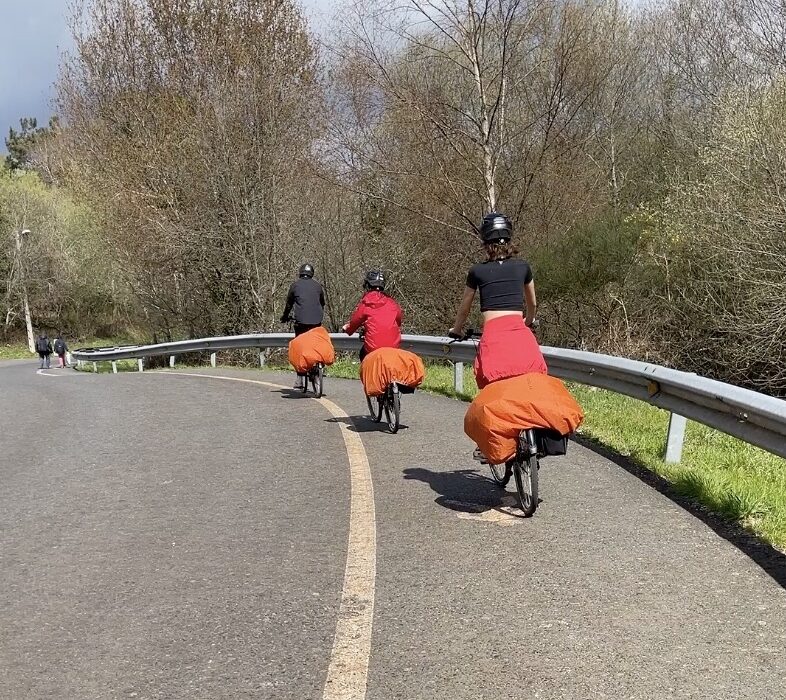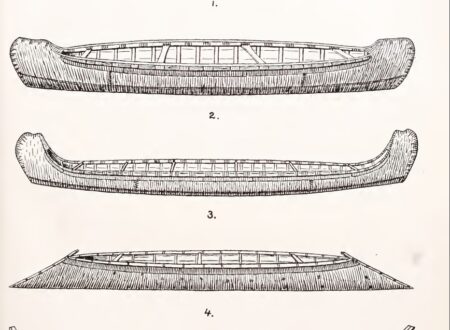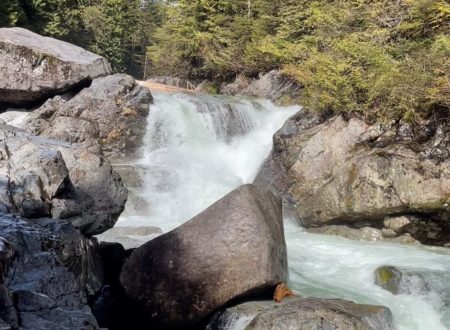PORTUGUESE COASTAL CAMINO OVERVIEW
The Camino de Santiago is a thousand-year-old pilgrimage network all over Europe which converges on the amazing cathedral in the town of Santiago de Compostella, Spain, that is built over the supposed remains of St James the Great.
The most popular version of the Camino is the Camiño francés (the ‘French Way’) that takes you through France and then parallel to the northern Spanish coast. The route we’re talking about today though is an alternative that is growing in popularity, namely the Portuguese Coastal Route which goes north along the coast of Portugal before crossing into Spain.
In March of 2023 three kids (ages 11, 16, and 19) and I completed the 280-kilometre coastal route from Porto, Portugal, to Santiago de Compostela, Spain, in 7 days of cycling, sleeping in pilgrim hostels, and eating local seafood. Here are the most important things you might want to know if you’re thinking about a similar trip…
- PORTUGUESE COASTAL CAMINO OVERVIEW
- THE CAMINO BY BIKE IN 24 SECONDS
- PORTUGUESE CAMINO OPTIONS
- GETTING THERE, GETTING BACK
- BIKE RENTAL AND MAINTENANCE
- ACCOMMODATION
- TOURS
- PILGRIM’S PASSPORT AND CERTIFICATE
- FOOD
- SUGGESTED PACKING LIST
- RESOURCES
- A SAMPLE ITINERARY FOR THE PORTUGUESE CAMINO
- DAY 1 – Lisbon to Porto
- DAY 2 – Porto to Vila do Conde
- DAY 3 – Vila do Conde to Caminha
- DAY 4 – Caminha to Tui
- DAY 5 – Tui to Pontevedra
- DAY 6 – Pontevedra to Padron
- DAY 7 – Padron to Santiago de Compostella
THE CAMINO BY BIKE IN 24 SECONDS
Here’s a quick overview of what the cycling between Porto and Santiago de Compostela looks like…
PORTUGUESE CAMINO OPTIONS
The Camino in Portugal splits, divides, and changes names. It’s more of a network than a single, well-defined trail. This can make following directions confusing.
The best explanation of the different routes I’ve seen so far comes from the Stingy Nomads site, which breaks it down using this diagram…
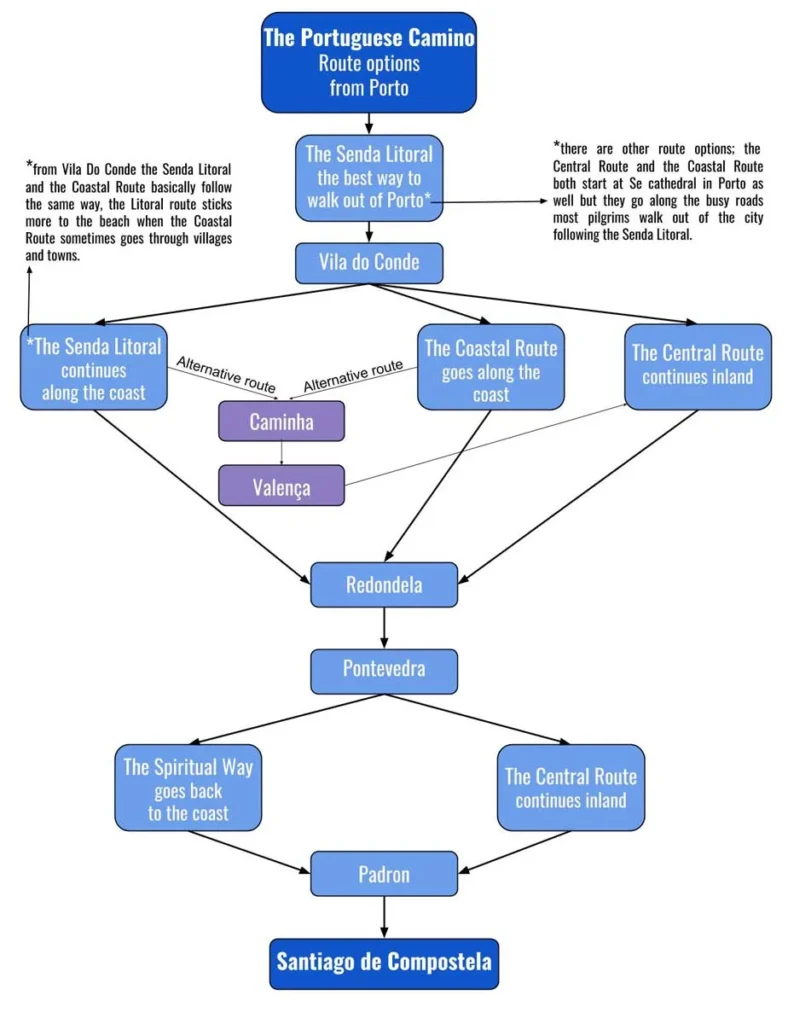
The first choice you’re going to have to make on the Portuguese Camino is whether you’re going to go inland along the Central Route, or along the ocean using some combination of the Litoral and Coastal routes.
The Litoral and Coastal routes are much flatter than the Central route, and are used by 90% of cyclists going from Porto to Santiago de Compostela. Not only is the route more bicycle-friendly, most of the hostels (albergues) and hotels are also set up to store your bikes overnight. This is the route we followed, and it’s the route I would recommend to almost everyone.
The main problem with the Litoral route is that you end up on the beach a lot. It can be problematic to push a heavily laden bicycle through sand. That being said, the sandy sections are usually pretty short.
The Litoral and Coastal routes are close enough that you can jump back and forth between them if you want a change of pace. Again, think of the Camino as a network of trails that all connect to each other.
We mostly stayed on the Camino itself, but did go out onto the smaller highways once in a while to get onto smooth asphalt because many of the roads in Portugal are cobble streets which are slow going.
GETTING THERE, GETTING BACK
Although you could theoretically start anywhere, the two most common starting points for cycling are Lisbon and Porto. Porto is roughly 250 km from Santiago and Lisbon is 600; to get a certificate of completion at the Cathedral, you need to have covered at least 200 km on bike (or 100 km on foot), so both of these starting locations work.
We didn’t have enough time to do the trip all the way from Lisbon, so instead we flew to Lisbon and then took the high-speed train from Lisbon to Porto. There are multiple train stations in Lisbon, so make sure that you’re going to the right one!
We took our train out of the Estação do Oriente (or the Oriente Train Station), which was opened when Portugal hosted the 1998 World’s Fair. This is the main train station connecting Lisbon to other cities, so the odds are good you’ll also be walking underneath its wild glass and metal lattice roof.
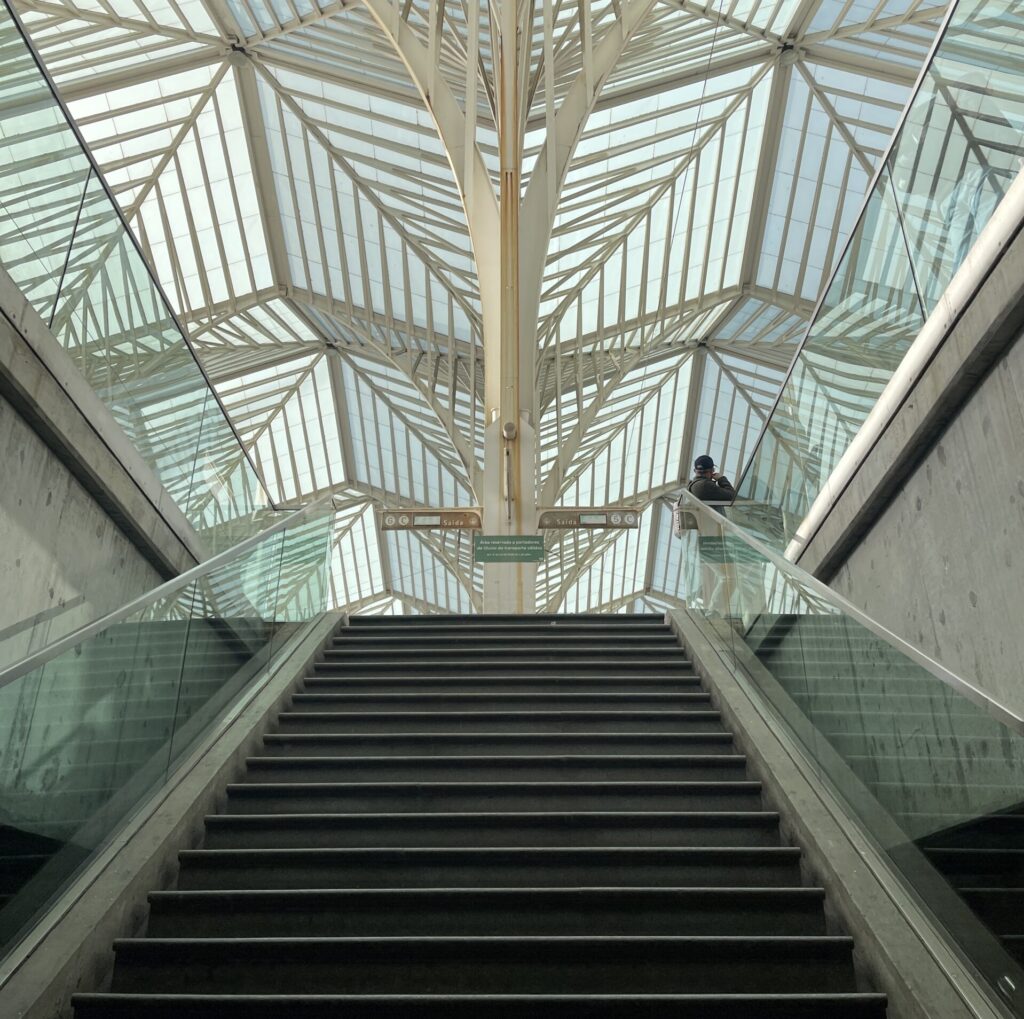
The train from Lisbon to Porto is as a pleasant 2.5-hour high-speed ride through the Portuguese countryside.
When you arrive at the Campanha train station in Porto it’s an easy 20-minute walk or 5-minute taxi ride from downtown Porto.
Porto is an amazing city, and you’d be well advised to plan to spend at least a full day here. There’s a ton of history, nightlife, and things to do.
Among your other activities, make sure to visit the Porto Cathedral to pick up your passport and get your first stamp. You’ll need this stay in the albergues along the way and also to get your certificate of completion at the end of the trip. The attached cloister is well worth visiting as well!
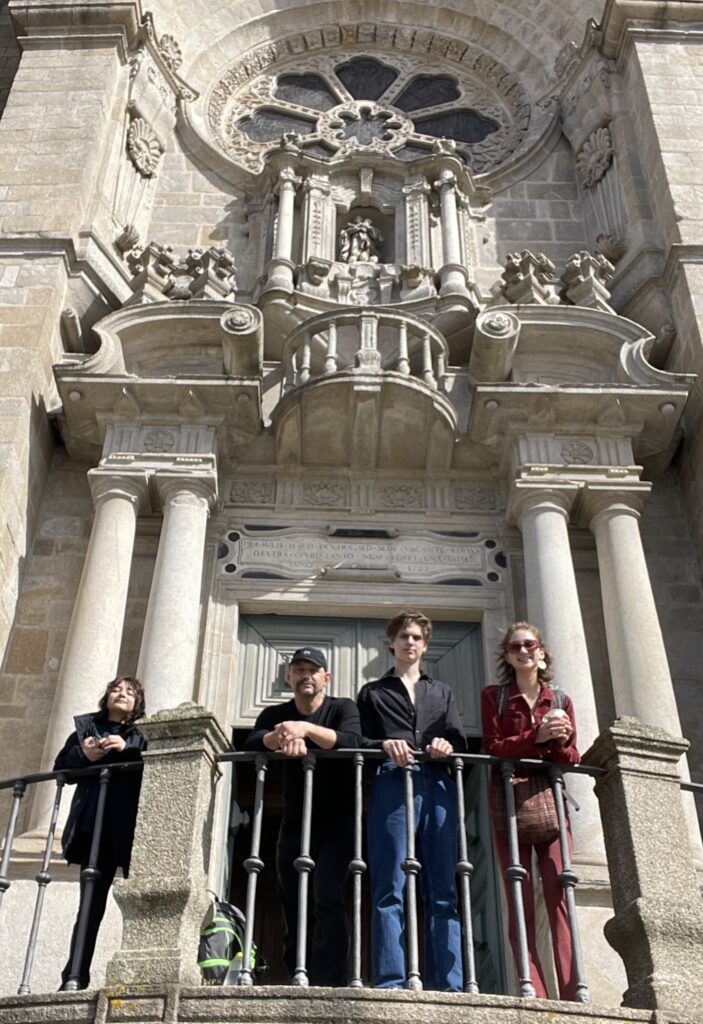
Once you get to the end of the trip in Santiago de Compostella you have several options to get home.
First, there’s a train station that connects you to the rest of Europe.
Secondly, there’s a small airport 15 minutes outside of town. During peak season (May to September) this is a busy place, with many flights coming and going. In the shoulder season there are less flights – you may only have one or two options per day.
Third, there are shuttle services that will bring you and your bikes back to Lisbon, but honestly, I would just take the train.
BIKE RENTAL AND MAINTENANCE
What kind of bike should you use for the Portuguese Camino?
The first question you need to think about is what kind of bike should you use for the Portuguese Camino?
Unless you plan on significantly altering the route and staying on paved roads and highways, you do NOT want a road bike. There’s simply too much rough terrain on the actual Camino, you’ll be very uncomfortable, and your road bike will get destroyed.
Your choices are basically renting a touring bike or a more ruggedly built mountain bike.
The Coastal Route is the most bike-friendly option, and is used by roughly 90% of cyclists going from Porto to Santiago de Compostella. But even the Coastal Route takes you over a fair amount of cobblestone, dirt, and wooden boardwalk. Touring bikes with front suspension are probably the right choice for going along the ocean.
If you choose to do the Central Route (the one that goes away from the ocean and through the hills in the interior), then you should get a mountain bike with thicker tires. There will be some bumpy sections that will batter a less sturdy bike quite badly.
Bike Rental in Porto and Tui
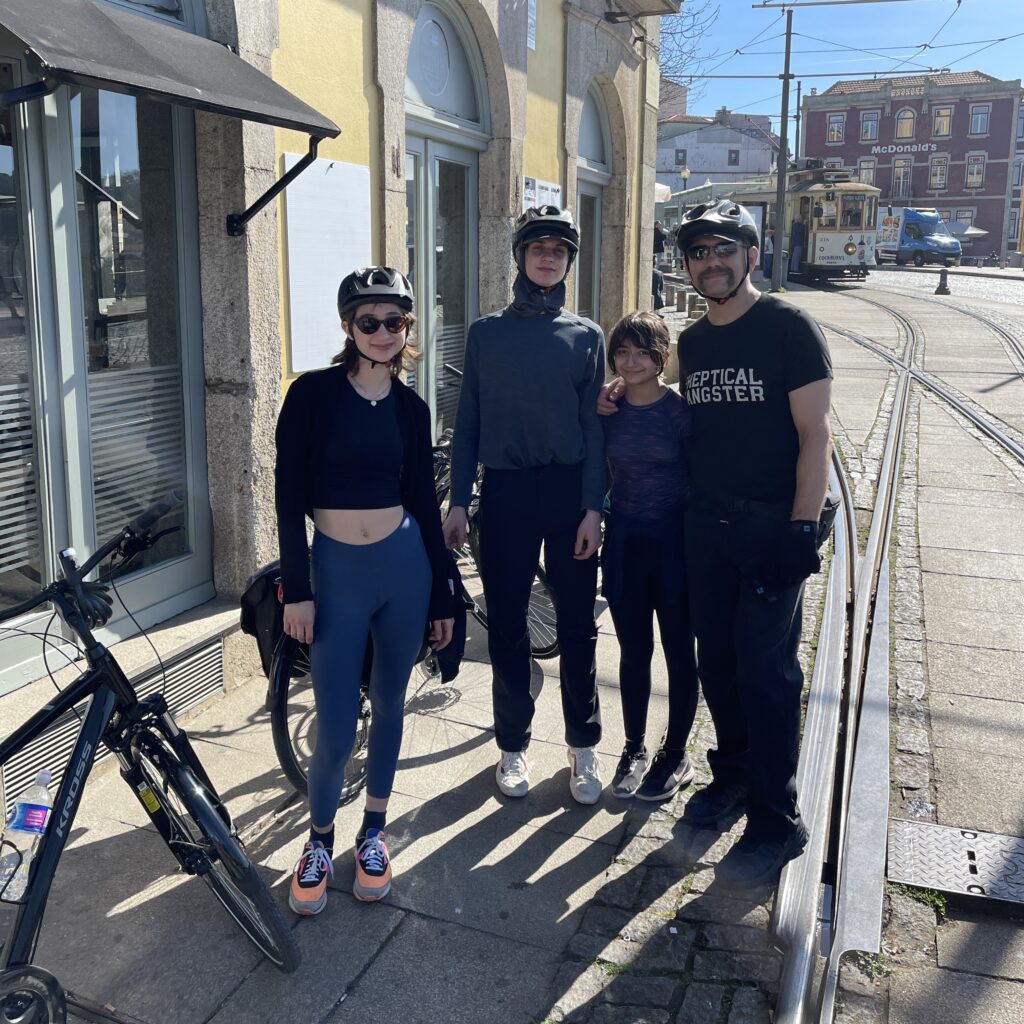
There are many bike shops in the bigger cities, and most of them can accommodate long term rentals
Many companies (like Camino Ways, Utracks, Cycling Country, and others) offer bike rentals but only as part of package deals where they also provide hotel accommodation and bike return service for one inclusive fee.
Because I had kids with me and wasn’t 100% sure how far we’d be able to travel on any given day, I opted for the increased flexibility of renting bikes and then finding accommodation separately. That way, we weren’t constrained by having to reach a specific hotel in a certain town on a given day.
We rented Kross Trans 5.0 touring bikes from Vieguni Bikes and Scooters which is located on the river in Porto. This was very convenient – after you leave the shop you turn right onto the bike path that goes along the river and – hey presto – you’re on the Camino!
These bikes came with helmets, front suspension, locks, fenders, lights, luggage rack in the back, bungee cords, air pump and repair kits. Unless you have your own you’ll probably want to rent saddlebags which often come with raincovers. Most shops offer 15 or 20 litre bags for a few euros a day – I would suggest the 20 litre bags unless you’re a light packer.
The total cost in 2023 for 4 bikes and 7 days was about $800 Euro, which included bike rental AND transportion of the bikes back to Porto from Santiago. The kids did smash the bikes up a little bit on the trip (scratches, broken derailleurs, smashed pedals, etc), which Vieguni charged us an additional an additional $150 Euro to fix, which I thought was totally fair (honestly, I thought it would be more).
Here are the other bike rental places I emailed with and a rough estimate of the 2023 prices. Everyone was polite and spoke English, and I didn’t need to speak Portuguese to communicate.
- Northroad (4 x touring bikes for 7 days for 420€, bike shuttle service 400€), Saddle bags and repair kits an additional 5€ per day
- Velurb (4 x ‘special’ bikes for 7 days for 420€, bike shuttle service 280€), Saddle bags and repair kits included with special bikes
- Tricla (4 x mountain bikes for 7 days for 420€, bike shuttle service 220€), Saddle bags and repair kits included with special bikes
Important: reserve your bikes as far ahead of time as possible. During the summer the bike shops are very busy and can definitely run out of rentals.
Repairs
Most bicycle rental facilities are willing to give you a free repair kit with your rental that typically includes the basics like:
- Replacement inner tubes
- Inner tube patches
- Chain link replacements
- Tire levers
- A folding bike tool with allen wrenches, chain breaker, and screwdrivers
- Tire pump
- Spoke wrench
If you’re going to do trip like this it’s important that you can do basic bike maintenance. There are bike shops en route, but getting to them could be a lengthy and expensive process.
Know how to do the basics yourself, including repairing and replacing a flat tire, fixing a broken chain, adjusting a derailleur, adjusting the position of seats and handlebars, tightening brakes and replacing pedals.
ACCOMMODATION
Most people, ourselves included, end up using a combination of albergues (pilgrim’s hostels) and regular hotels for overnights. Both are plentiful along the route.
There are both public and private albergues; the public ones are usually a little bigger, a little more affordable (c. €10/night) and require you to have a pilgrim’s passport. Public albergues are often maintained by volunteers who might meet weary travellers at the door with a plate of fresh cookies or a bowl of lentil stew. The private albergues are usually a little nicer, a little more expensive (€10-20/night) and don’t require a pilgrim’s passport.
Albergues often have a kitchen for pilgrims to use, but occasionally you’ll run into ones that only have a microwave and a vending machine.
Albergues, especially the public ones, usually operate on a first-come-first-served basis. You often can’t book ahead, so try not to be the last person arriving!
There are hotels all along the route, which range widely in price and quality. We treated ourselves to hotel rooms a couple of times, including after one memorable rainstorm coming into Viana do Castelo after which we were soaked to the skin.
Every albergue and hotel we stayed at had bike storage facilities, which was very convenient.
TOURS
There are numerous companies offer tours, but we didn’t use them. We just rented the bikes and made our own way from hostel to hostel. Finding accomodation, was never a problem and we preferred the flexibility of just choosing a hotel or a hostel at the last minute rather than HAVING to make a certain hotel at a certain time.
If we had been travelling during peak season (July and August) then we might have had to plan our accommodation further in advance.
PILGRIM’S PASSPORT AND CERTIFICATE
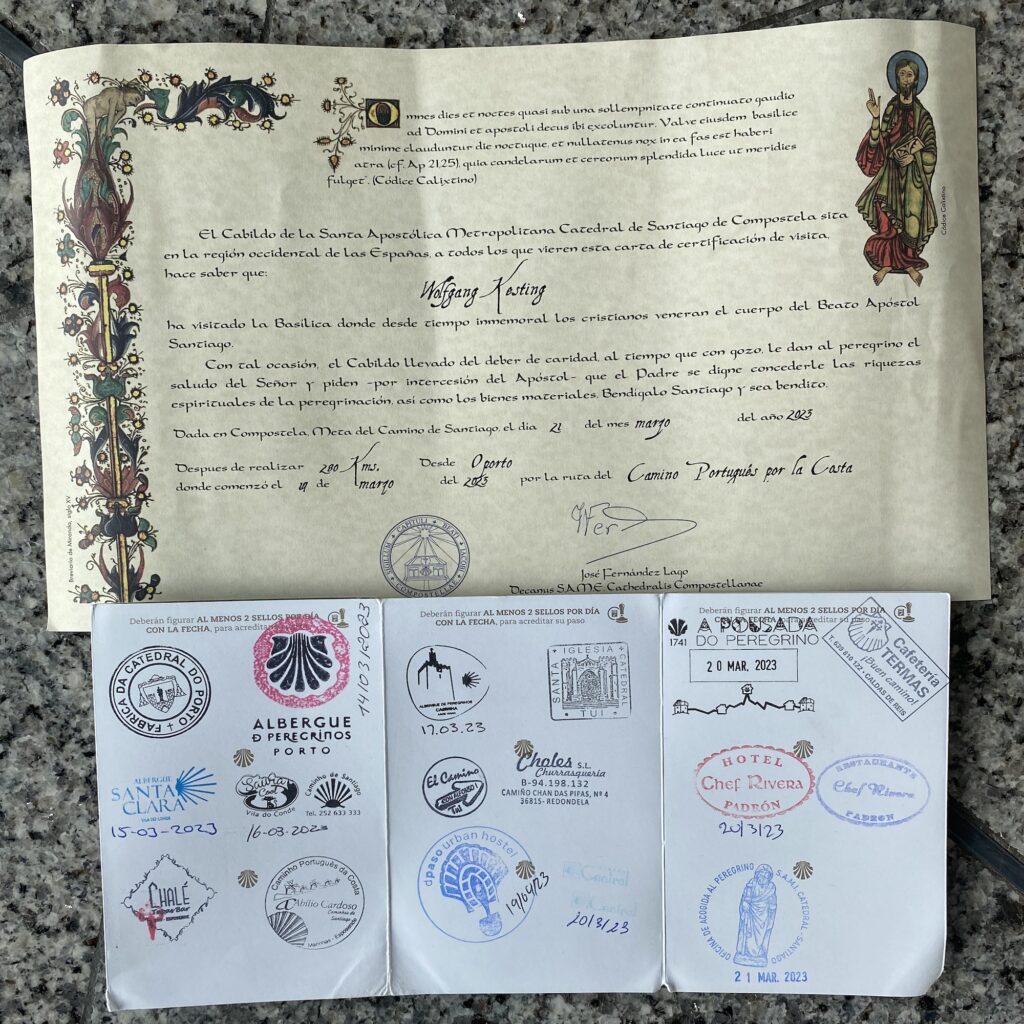
The pilgrim’s passport identifies you as a traveller on the Camino and entitles you to stay in the public albergues. It’s also necessary to have a filled out passport to collect your Compostela pilgrim’s certificate at the pilgrim’s office in Santiago de Compostela.
To be valid the passport should be stamped twice daily, usually once where you sleep and once at a café, restaurant, museum or major church which almost all offer stamps.
To be eligible for the certificate you have to travel at least the last 100 kms to the Cathedral of Santiago if you are walking, or cycle at least 200 kms if you are travelling by bicycle.
FOOD
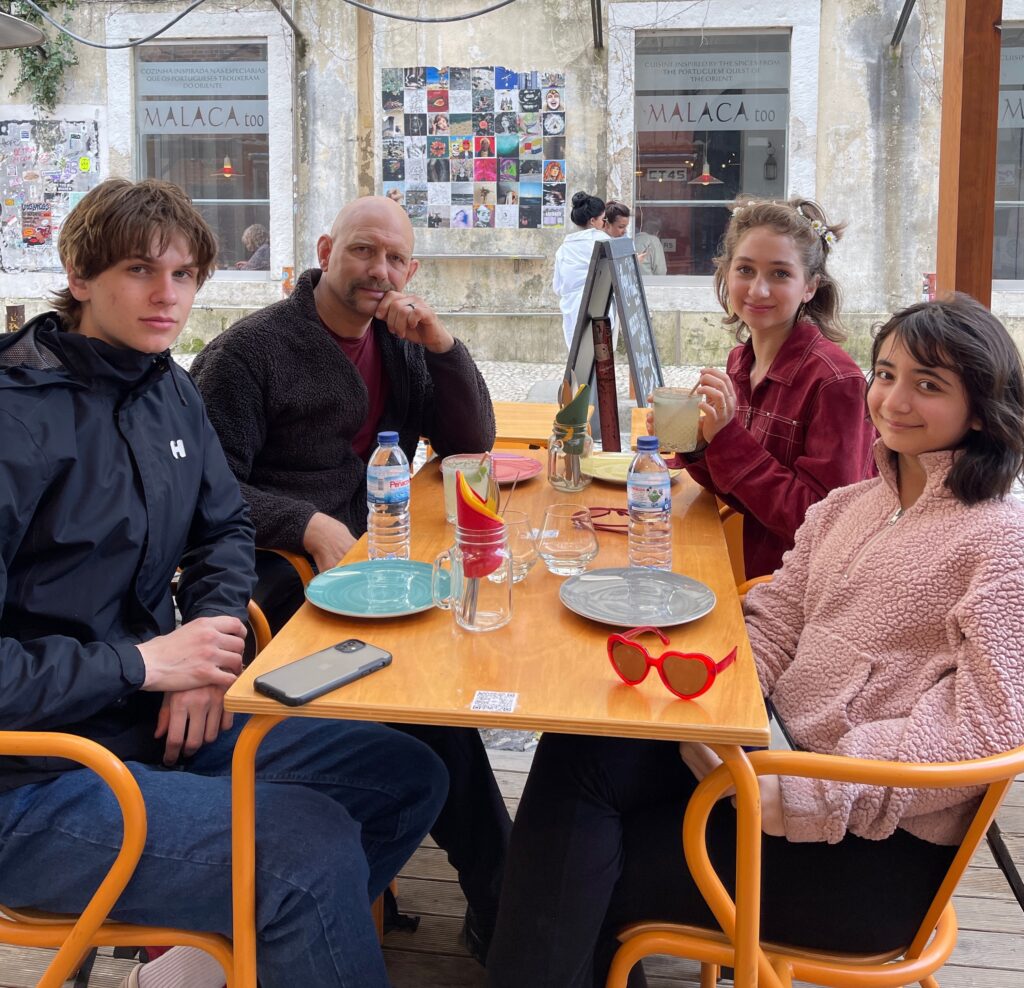
There is no shortage of restaurants, cafés and supermarkets along the route. The seafood along the coast is amazing, and watching the menus transform as you travel north (and especially as you cross the Portuguese-Spanish border) is fascinating.
The only problem with restaurants might occur in Spain – many restaurants don’t open for lunch until 1 pm and don’t open for dinner until 8 pm. This can be problematic if you roll into town in the early afternoon hungry and thirsty!
SUGGESTED PACKING LIST
Here is the packing list we used. It was March, and thus we had to plan for cold weather.
Note that it is almost impossible to get girls to adhere to this (‘What? I’m going to Europe?!? I’m DEFINITELY going to take eight different outfits…“) but everything still fit into 2 x 20 litre saddlebags.
If you’re planning on touring around Europe before or after your bike trip then you might want to look into luggage services that transport your suitcases (or whatever) from Porto (or wherever) to a hotel at the end of the trip in Santiago de Compostela.
Individual Gear
- 1 x Merino wool T shirt
- 1 x Merino wool long sleeve shirt
- 1 x Long sleeve shirt
- 1 x Padded cycling pants
- 1 x Long nylon pants (no jeans!)
- 1 x Shorts
- 1 x Swim suit
- 5 x Socks (including 1 x wool socks)
- 5 x Underwear
- 1 x Cycling shoes
- 1 x Sandals or flip flops
- 1 x Rain coat
- 1 x Rain pants
- 1 x Hat/cap
- 1 x Sunglasses
- 1 x Padded cycling gloves
- Phone & charger
- 1 x Camino passport
- 1 x International passport and ID
- 1 x Sleeping bag liner
- 1 x Light nylon day bag
- Hygiene and medication
Group Gear
- 1 x Quick dry towel
- Basic first aid kit (tape, bandaids, antibiotic cream)
- Sunscreen
- Hand sanitizer
- Toilet paper
- Multitool
- Headlamp
- Camino guidebook
- Bike repair kit (came with the rental)
RESOURCES
The main branches of the Camino are marked at regular intervals by yellow scallop symbols and yellow arrows. This makes navigation fairly easy.
Still, it’s good to have some options in case you want to plan ahead and/or bypass certain sections, which is where the books, apps, and sites come in.
Books
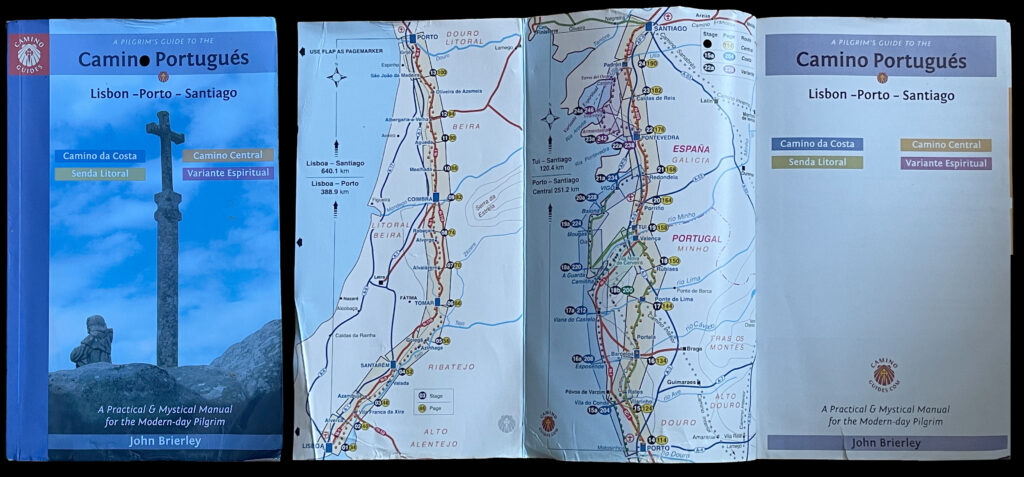
There are many books written about the Portuguese Camino, but the one that everyone on the trail seems to be carrying is A Pilgrim’s Guide to the Camino Portugués, by John Brierly. I’m not wild about the layout of this book, but it is small, light, and absolutely packed with information. It’s a great backup if your phone runs out of power or if you end up in a place with no reception.
If you find a better guidebook please let me know!
Bike Navigation Apps
You’ll have cell coverage for almost your whole trip, meaning you can use phone-based apps for navigation on your bike. These are very useful if, for some reason, you wish to depart from the Camino and find an alternate route to your destination.
There are MANY navigation apps, but the two we used most often were Google Maps and Bikemap. Please let me know if there better options on the market that you use!
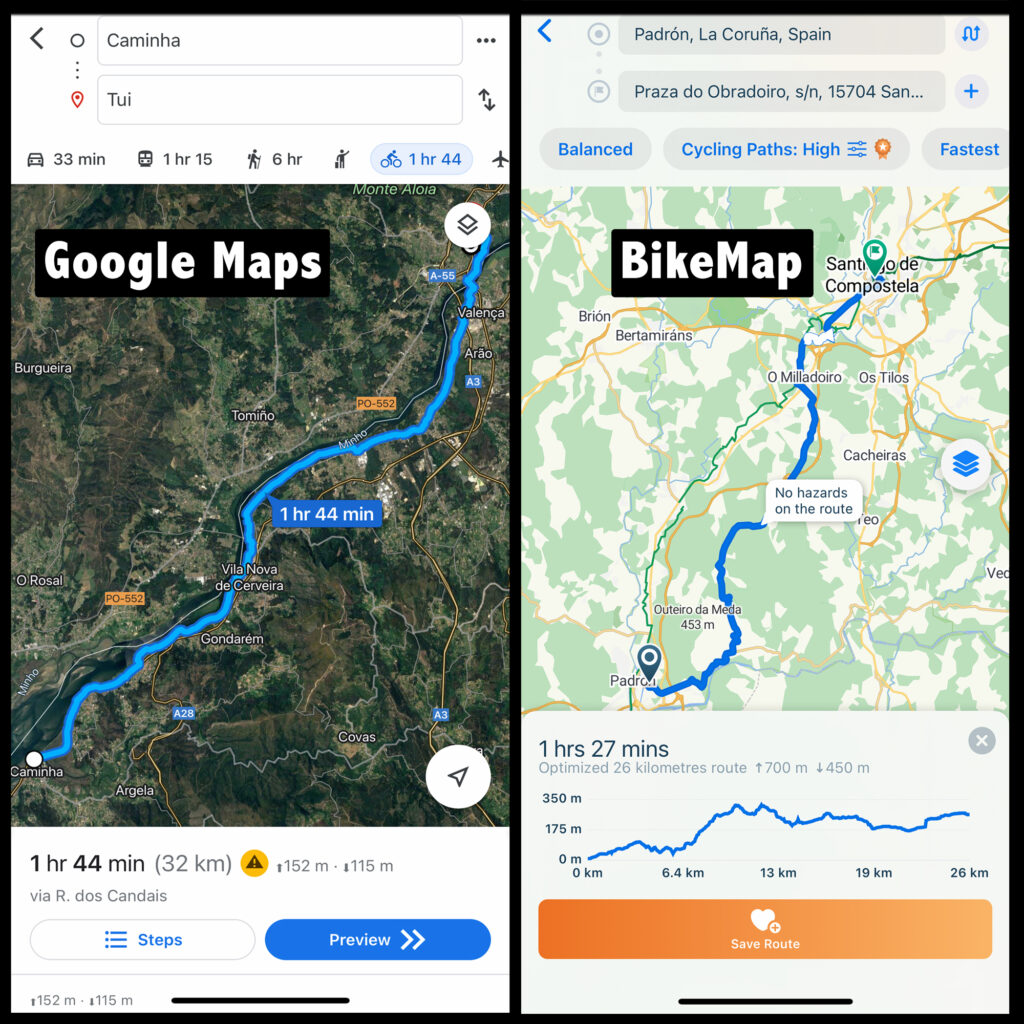
Google Maps (click here for iOS and here for Android) has a very intuitive interface but doesn’t always keep you on the bike paths or on the Camino. Still, it’s a reliable way to get from point A to point B if you select the bicycle icon as your mode of transportation.
BikeMap (click here for iOS and here for Android) is an app that’s much more specialised for cycling; it allows you to specify the type of bike you’re using, whether you want to take the fastest route or stick to bike paths, to record your ride, etc.
I recommend using a combination of apps to get the best sense of your options for the day.
Important: on a bike it’s dangerous to continuously be looking down at an app to find out what the next direction is going to be. Therefore I suggest using voice navigation and an earbud in one ear to follow the navigational prompts.
Apps for Foot Navigation and Finding Accomodation
There are lots of apps catering to people doing the Camino on foot which might be useful too since 99% of the coastal route is suitable for both walkers and cyclists.
My two favorite Camino apps were the Wise Pilgrim App (click here for iOS and here for Android) and the Buen Camino App (click here for iOS and here for Android), but also check out a detailed overview of the top 5 Camino apps.
That being said, to find accommodation most of the time I just entered the word “albergue” and the city name into google or google maps (e.g. “albergue tui”). That always revealed the main places to stay in town.
A SAMPLE ITINERARY FOR THE PORTUGUESE CAMINO
Here’s a quick day-by-day overview of the weeklong trip we did by bike from Porto, Portugal to Santiago de Compostella, Spain…
DAY 1 – Lisbon to Porto
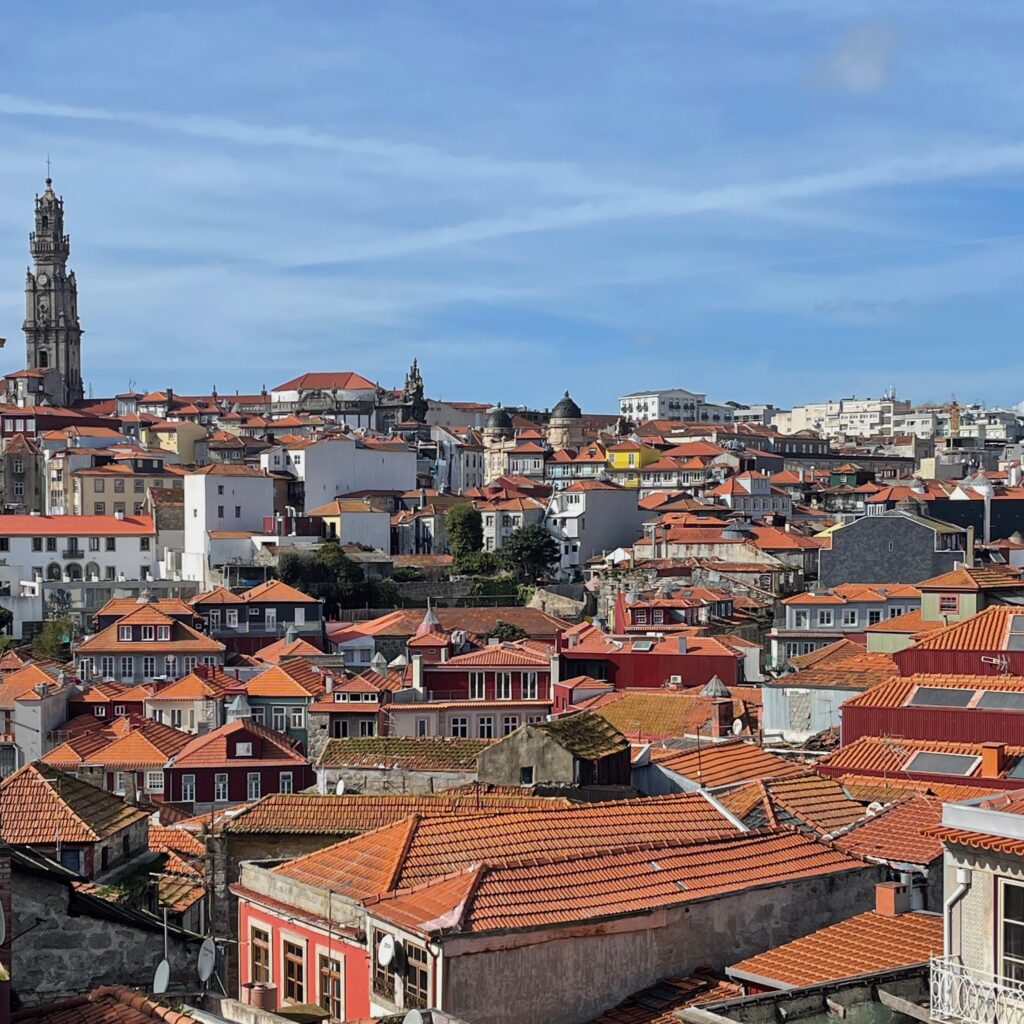
To get to Porto we took the high-speed train from Lisbon, starting at the Estação do Oriente train station. This station is located in the old Expo 98 site, a 15-minute taxi ride or a 30-minute bike ride from downtown Lisbon. The ride from Lisbon to Porto took 2 1/2 hours and passed through some lovely Portuguese countryside.
Porto is gorgeous. Ideally you’d spend an entire day here exploring the steep hills bedecked with clay tiled houses, winding alleys, and churches. There’s a lot to see here, including the 75 meter tall Torre dos Clérigos belltower, the Cais da Ribeira riverside promenade, gardens, parks, beaches, museums and churches.
You’ll be wanting to visit the Porto Cathedral to pick up your Camino passports and and get them stamped for the first time. That passport will allow you to stay in the public albergues along the way so don’t forget about this!
My suggestion would be to stay in or close to Porto old town, the region around the Cathedral where tiny alleys take you back to the Middle Ages.
DAY 2 – Porto to Vila do Conde
Porto to Vila do Conde is an easy 4 hour ride along mixture of asphalt, wooden boardwalks, cobblestone streets and sand. The sand is particularly slow going – you will probably need to push your bike at times – but that’s compensated by wonderful views of the ocean.
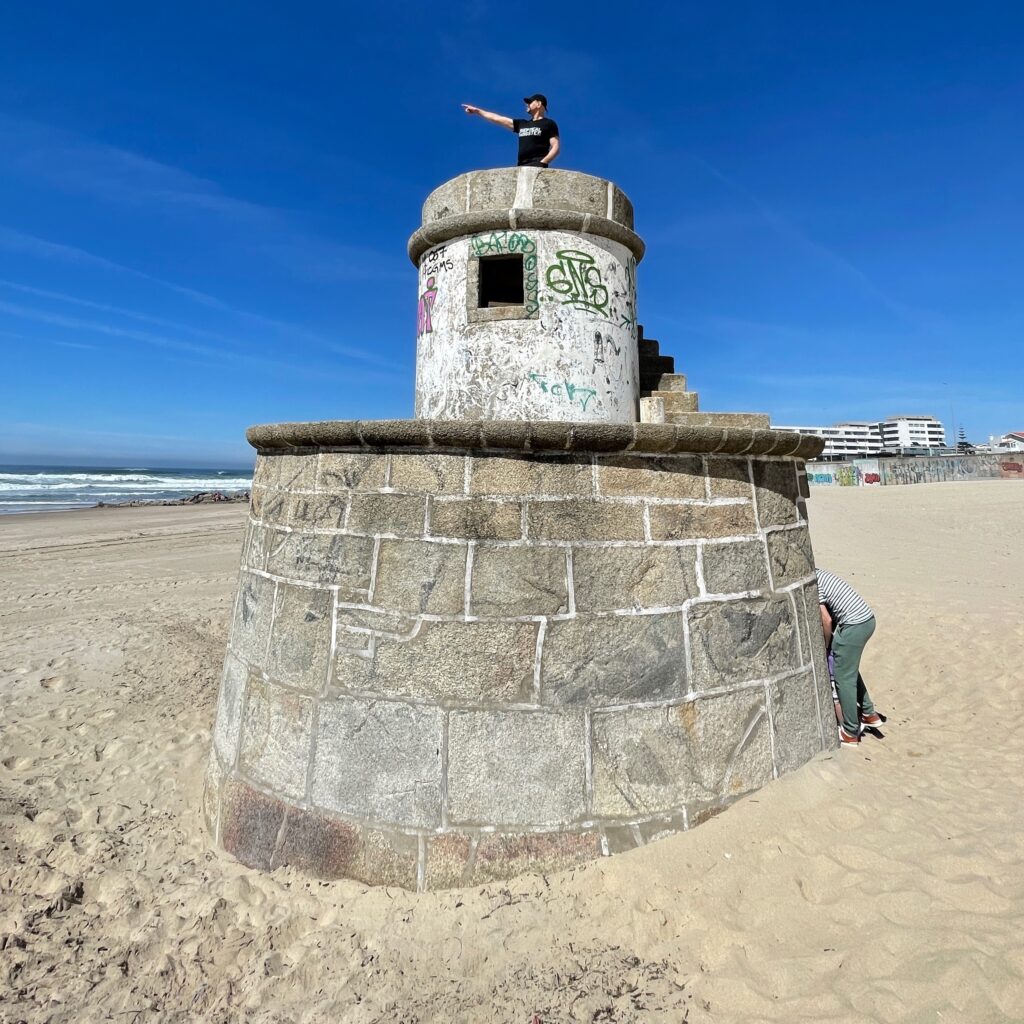
One particularly nice beach is about an hour out of Porto and is called Meia Laranja beach (Praia da Meia Laranja in Portuguese). Here Atlantic surf crashes down on a mixed shoreline of rock and white sand. There are restaurants and cafes on the beach as well as a cool abandoned lighthouse.
There are many more beaches and boardwalks until Praia de Mindelo, at which point the Camino turns inland and follows cobblestone roads through a mix of houses and farm fields until you come to Vila do Conde.
Vila do Conde is primarily a beach town blessed with a lovely shore. An aqueduct built in the 17th and 18th centuries to supply water to the monastery is visible in the hills above the town. There are a few churches you can check out, as well as the Nau Quinhentista, a replica Portuguese sailing ship from the Age of Exploration.
DAY 3 – Vila do Conde to Caminha
The stretch between Vila do Conde and Caminha is all about the beach, which lies to your left for most of the day.
You will become a connoisseur of road surfaces: the ancient cobble roads, which are beautiful but very bumpy and slow… boardwalks along the ocean which are scenic but quickly become very slow going if they get covered in sand… dirt roads which are good in dry weather but treacherous when they get muddy… and sidewalks where you are forever going up and down curbs… and wonderfully modern bike paths along the ocean where you feel like you’re flying.
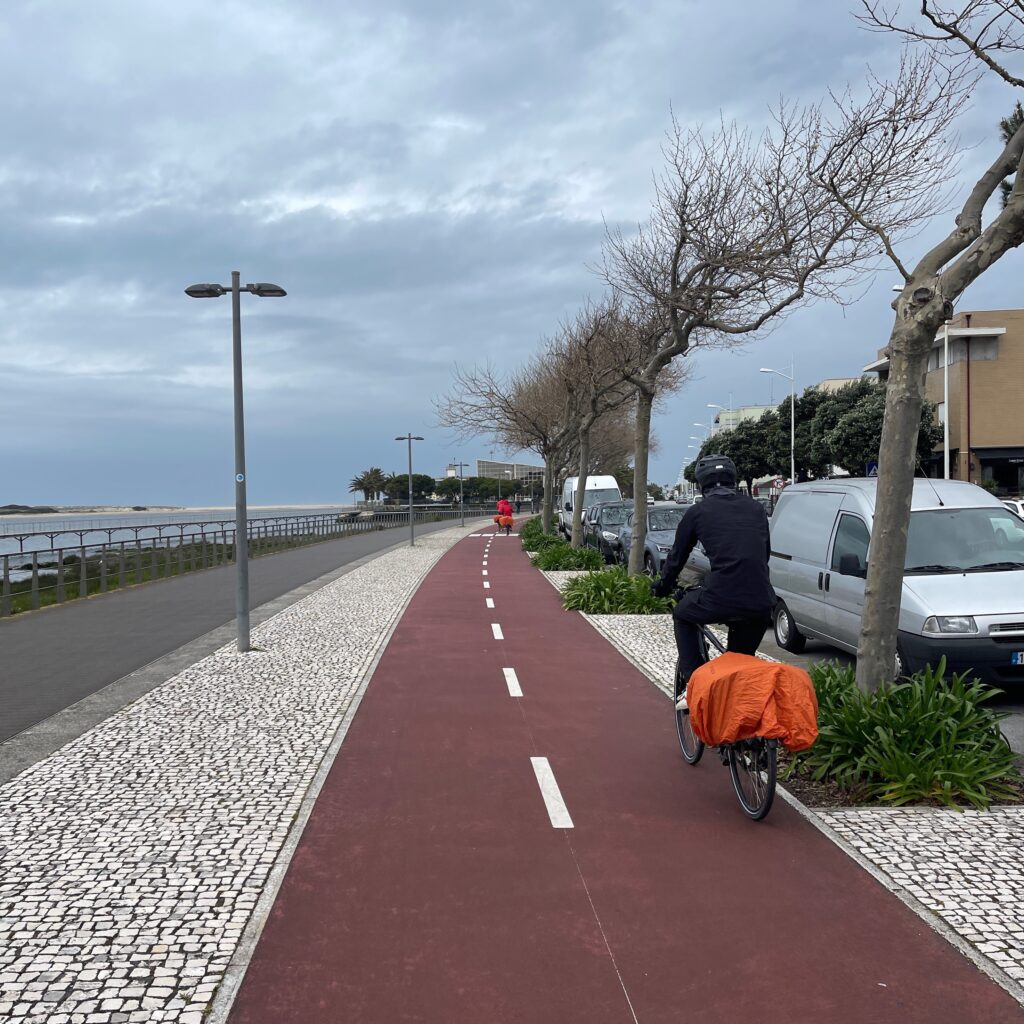
If you get tired, or if the weather turns on you, there are many accommodation possibilities before you get to Caminha, especially in the Póvoa de Varzim area.
There is a very interesting cemetery, the Cemitério de Fão, just before you cross the Cávado River.
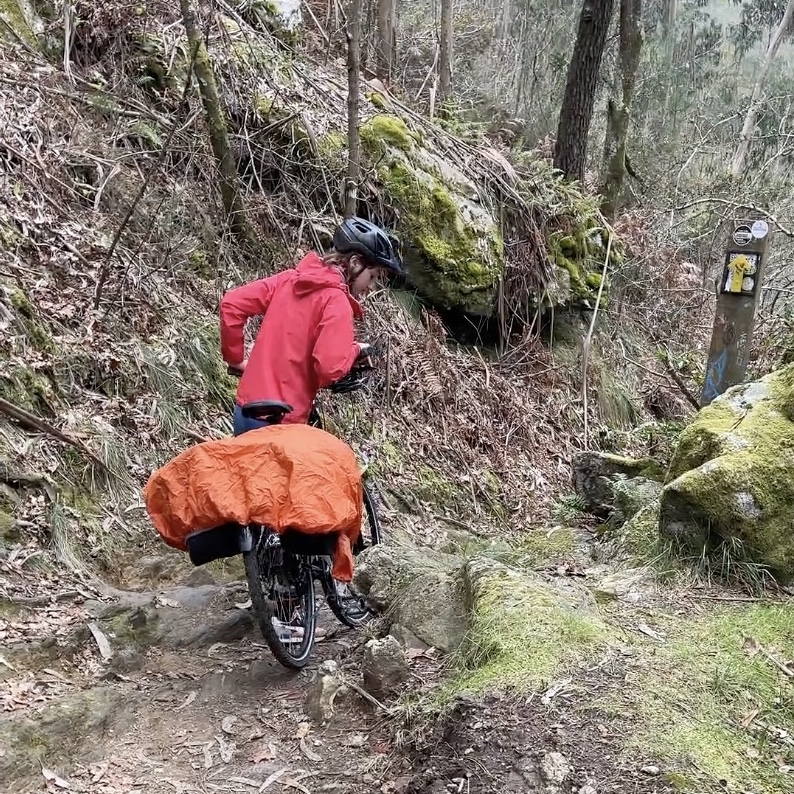
After the town of Belinho the trail eventually crosses the N13 highway and then enters the forest as it drops down to cross the Neiva River. The trail through this forest is quite rough, and you’ll definitely be walking your bike around boulders and down steep inclines at times, so you may want to consider bypassing this section. If there has been heavy rain recently, you may not be able to ford the river on the low-lying bridge and will need to back up and cross on one of the more conventional bridges.
Caminha is another one of those Portuguese towns full of winding alleyways and ancient stone buildings. The clock tower (Torre do Relógio) in the main square of Caminha is a remnant of a medieval castle that was started in the 4th and 5th centuries and then expanded during the Middle Ages due to the strategic importance of the town.
DAY 4 – Caminha to Tui
From Caminha the Camino turns away from the ocean and turns inland, heading towards the city of Tui.
At this point you have two major options… you can cross the mouth of the Minho River into Spain and travel along the Atlantic on the Senda Litoral, OR you can stay on the eastern bank of the river and follow one of the nicest bike paths on the whole trip to Tui and connect to the Camino Central. We went this second route, so that’s what I’ll describe.

That bike path from stretch from Caminha to Tui is lovely; you’ll cycle through shafts of sunlight piercing the tree cover and pass by fishermen and small agricultural plots
After 28 kilometers on the asphalt bike path beside the river you’ll pass by the walled town of Valença. The main attraction here is a fortress built in the 1200’s and several churches also dating from that period. If you have the time I would visit the fortress.
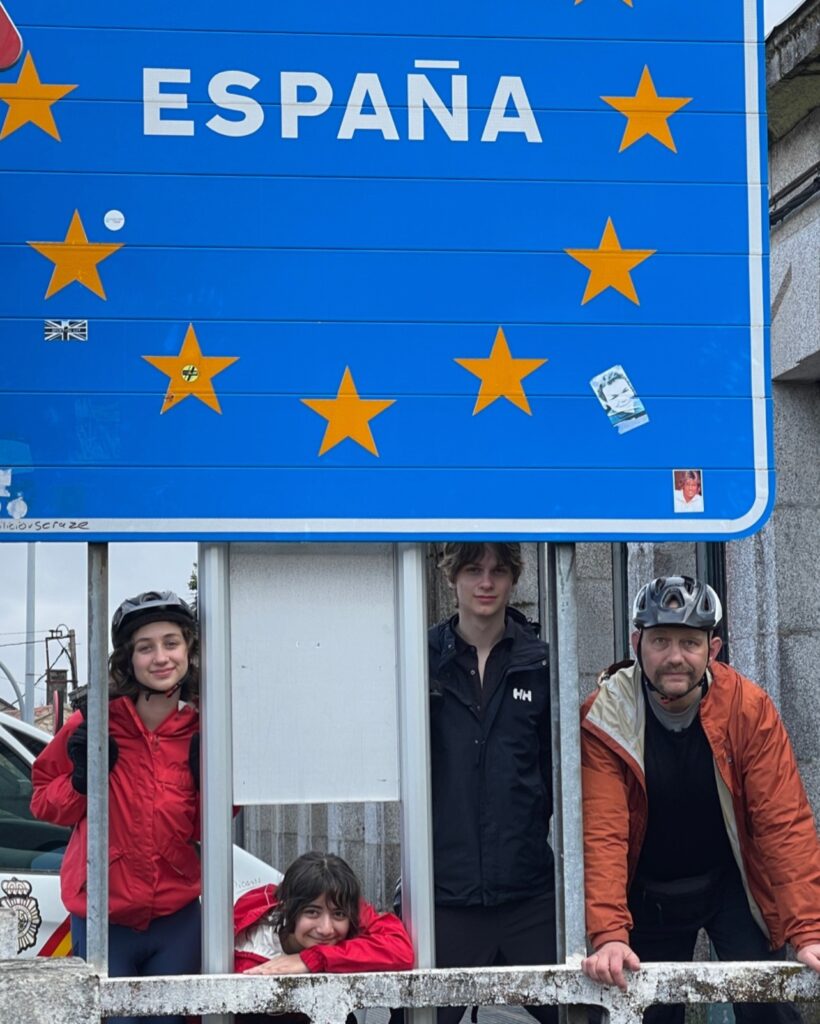
After Valença you cross a bridge into Tui, leave Portugal, and enter Spain. Tui is a typical medieval town with a fantastic cathedral and a vibrant gastronomic scene. It’s also the start of the shortened Camino; it’s 116 km from Santiago de Compostela which is long enough for pilgrims on foot to qualify for a Camino Compostela, or a certificate of completion. Therefore expect more pilgrims on the trail from this point onward.
DAY 5 – Tui to Pontevedra
Three out of four members of our party were sick with the flu today so I heavily modified the route between Tui and Pontevedra .
Normally the Camino tends to run through rural country lanes, forest paths, and the older parts of the cities. But this isn’t the straightest, smoothest, or fastest route.
By using a combination of Google Maps and Bikemaps I created a new, bike-friendly route that took us through the industrial area of Tui, then joined the Camino proper for about 10 km, and finally took us out onto a smaller highway with reasonably large shoulders for 15 km. I missed the rural scenery and didn’t like sucking the diesel exhaust and having large trucks whizzing by, but at least we finished the day fairly quickly.
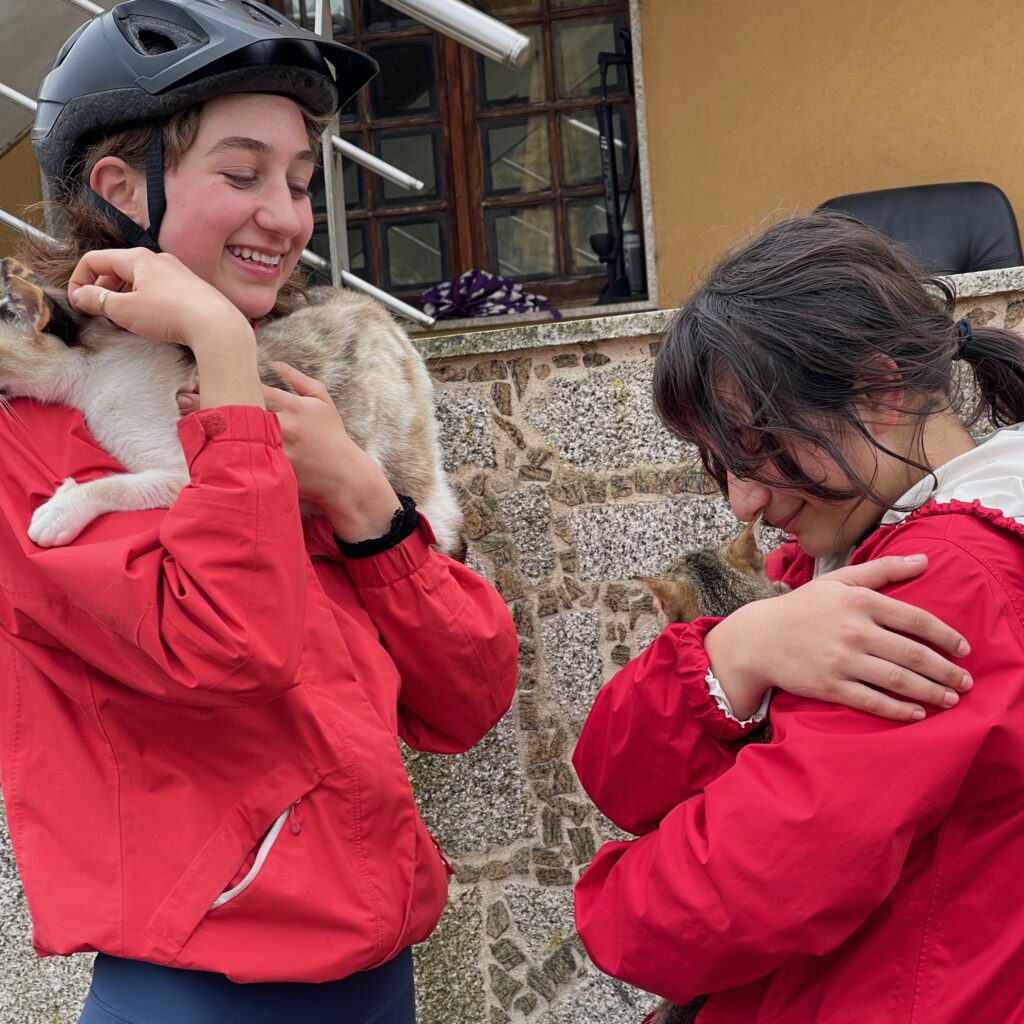
We finally arrived in Pontevedra hungry and tired. We checked into a futuristic hostel where everyone had their own coffin-like enclosure. Then we headed out for food and found out that despite Pontevedra being a town of 90,000 people and a tourist destination, there wasn’t a single restaurant, grocery store, or supermarket open between 4 and 8 on a Sunday. The Spaniards take their Sundays REALLY seriously.
While downtown check out the Church of the Pilgrim Virgin which is built in the shape of a scallop shell
DAY 6 – Pontevedra to Padron
There are 41 kilometers between Pontevedra and Padron, but the route is relatively bike-friendly, with lots of asphalt and densely packed dirt and gravel. This is one of the nicest sections so far, rivalling the 20 km bike path along the Minho River in Portugal. The trail runs through lots of tiny communities, forest trails with ancient moss-covered stone walls, and farm fields full of tiny plots.
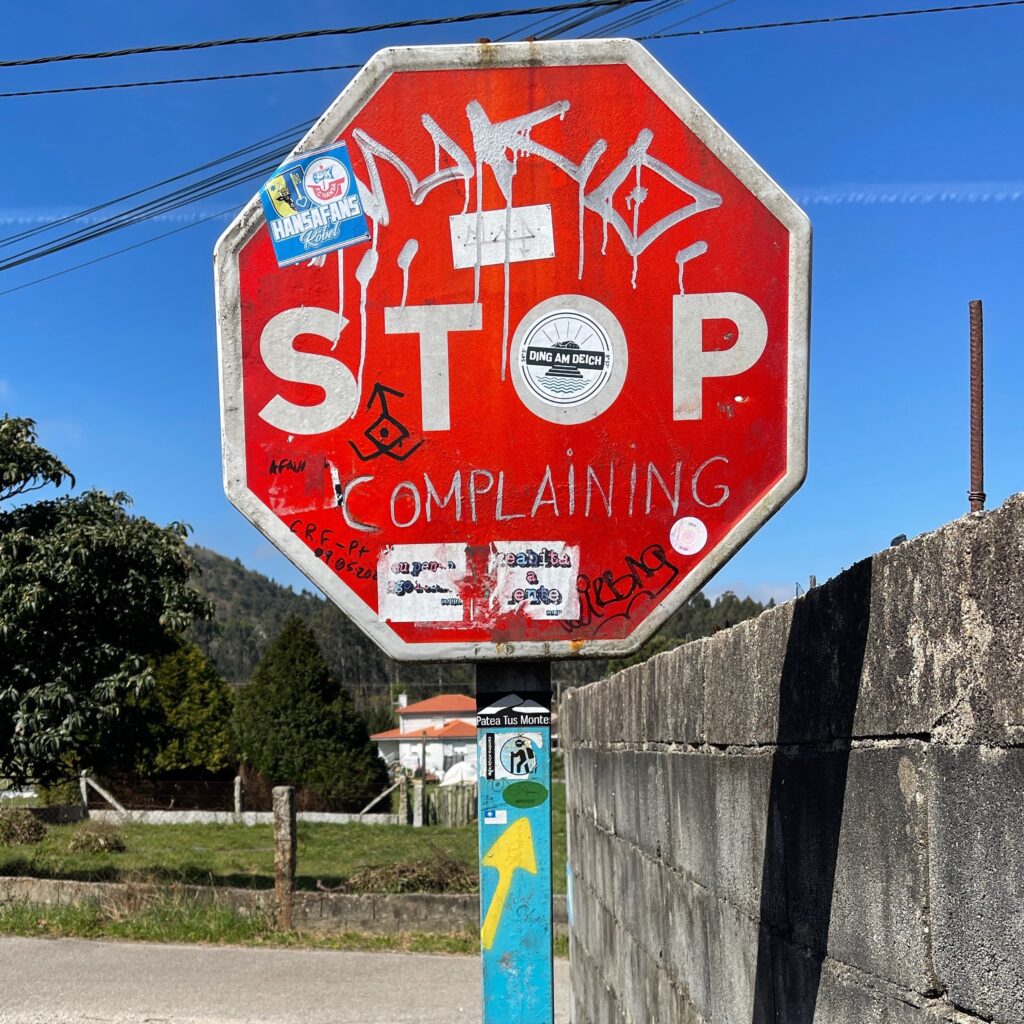
There are lots of cafes, restaurants, and interim albergues along this route, which reflects the increased number of pilgrims who started in Tui.
The town of Caldas de Reis lies about halfway between Pontevedra and Padron. There are lots of restaurants, hotels, spas, and even hot springs here to revive weary travellers.
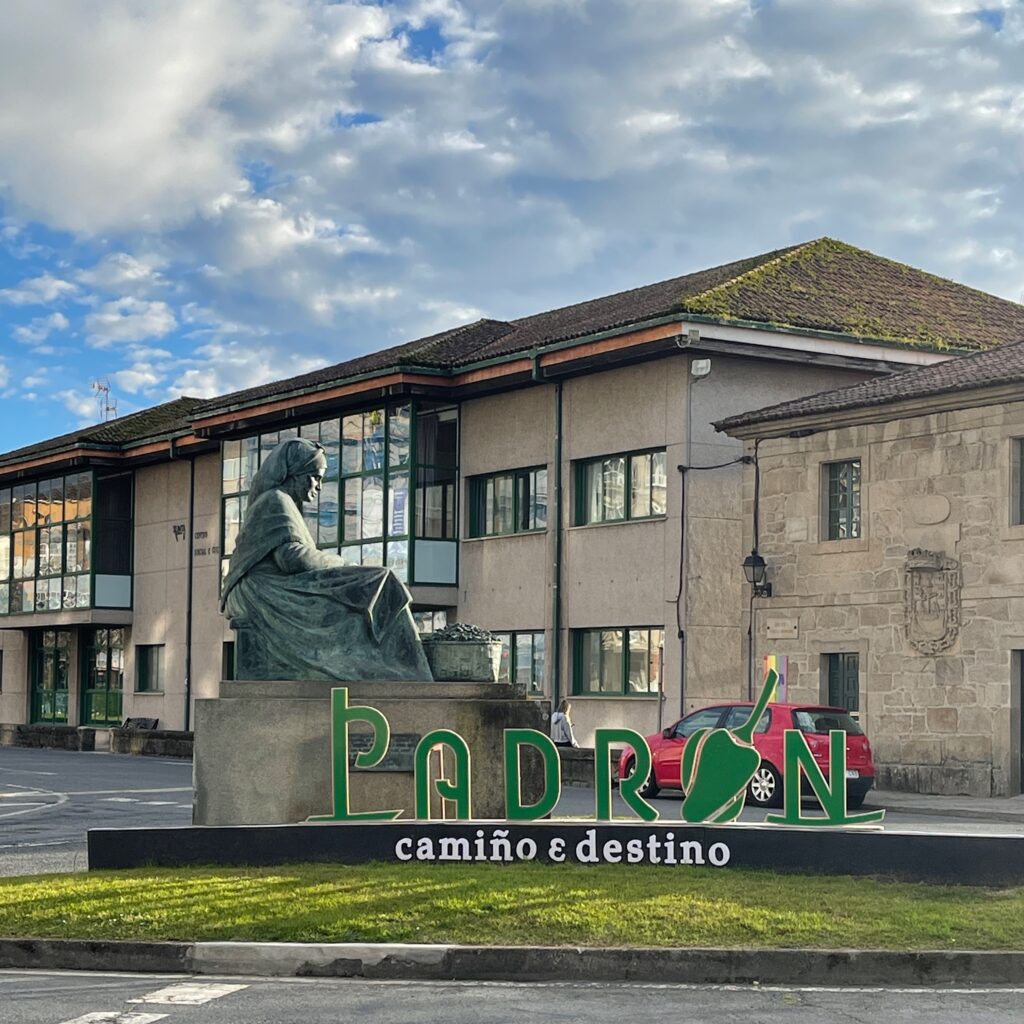
Padron is a small town with great dining and an important role in the story of the Camino; it is here, allegedly, where St James’ body was first reached Spanish shores after it left Jerusalem – the stone to which his boat was anchored can be seen in the parish church of Santiago de Padrón.
DAY 7 – Padron to Santiago de Compostella
The Camino from Padron to Santiago is mostly paved, with a few dirt sections through the forests. There are a lot of hills in this 25 kilometer section – the whole day is more or less a climb.
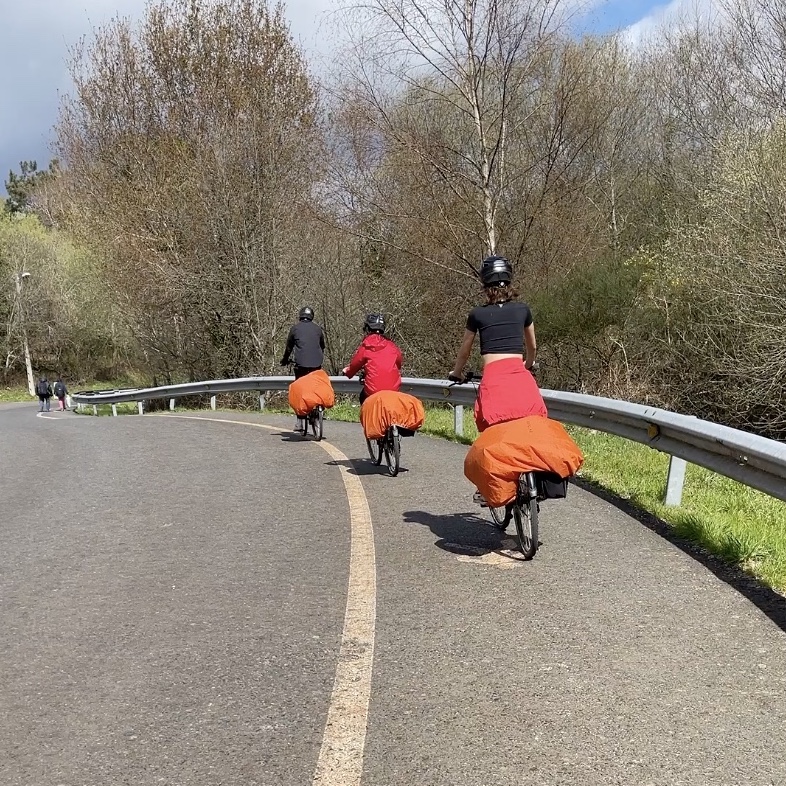
As you approach the outskirts of Santiago there’s an interesting moment where way markers point you in opposite directions without explanation. The reason for this is that there are two routes into the center of town – going left is more direct.
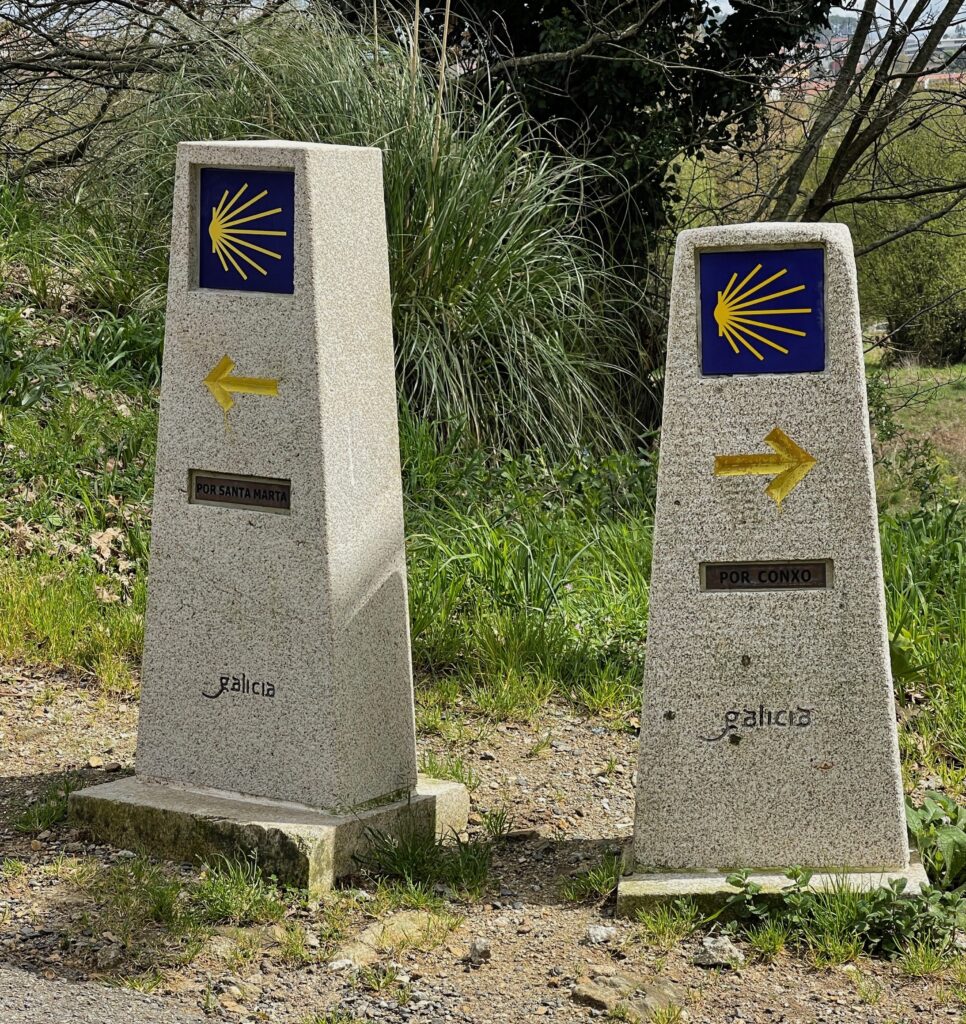
The final climb to the cathedral goes along urban streets and then ducks into the old city maze at the top of the hill.
The cathedral itself is gorgeous. This is one of the very few cathedrals allegedly built on the burial site of a saint, with Saint Peter’s Basilica in Rome being another notable example.
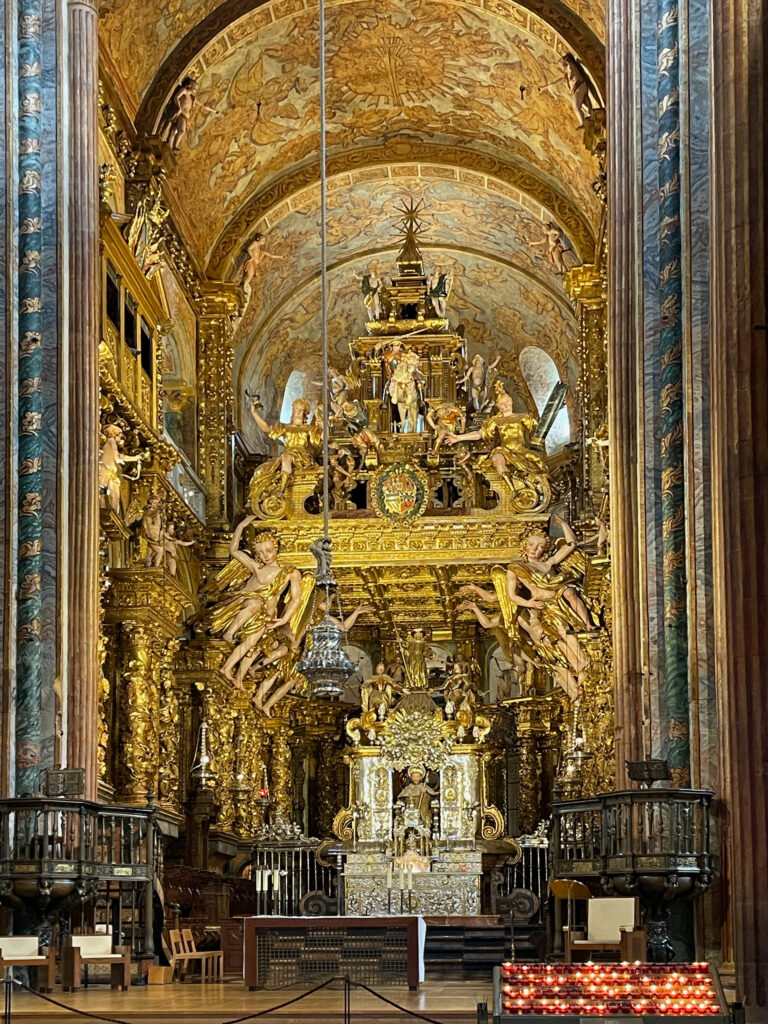
To get your official Compostela pilgrim’s certificate, you have to visit the Pilgrim’s Reception Office which is in a nondescript building at Rúa Carretas, nº33 (accessed from García Sabell), just down the road from the cathedral. It is open 9:00 am to 7:00 pm everyday except Christmas and New Year’s Day – if you finish your pilgrimage on those days you can get your certificate at the cathedral itself.
Have an amazing trip, and please let me know if you found this useful!


